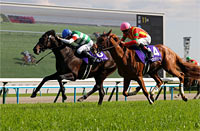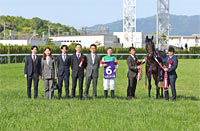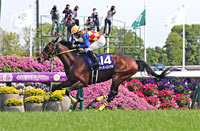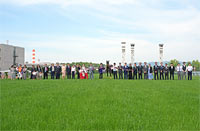Tenno Sho (Spring) (G1) - Data Analysis
Ultimate long-distance contest for older horses, won by a long line of champions
Of the eight winners in the Tenno Sho (Spring) races since 2014, seven had previously won a JRA G1 race, the exception being Rainbow Line in 2018. Even in 2021, when only two previous G1 winners entered the race, the Tenno Sho (Spring) was won by 2019 Kikuka Sho (Japanese St. Leger) winner World Premiere. We can therefore regard the race as a contest that determines the true champion among runners that have already reached the top in other races. As in 2021, the Tenno Sho (Spring) will be held at Hanshin Racecourse this year. Let’s now analyze some features shared by successful runners in the race based on results over the last 10 years.
Focus on runners that have won a JRA G1 or G2 race since previous year
Of the 30 Top 3 finishers in the last 10 years, 23 had experience of winning a 2,200-3,200m JRA G1 or G2 race since the previous year. Conversely, runners without such experience struggled with a Top 3 ratio of 6.7%. In other words, we should first check runners’ performance since the previous year. [Table 1]
[Table 1] Performance by experience of winning a 2,200-3,200m JRA G1 or G2 race since the previous year (last 10 years)
| Experience |
Performance
[1st-2nd-3rd-4th or lower] |
Win ratio |
Top 2 ratio |
Top 3 ratio |
| Yes |
8-9-6-39 |
12.9% |
27.4% |
37.1% |
| No |
2-1-4-98 |
1.9% |
2.9% |
6.7% |
In addition, among the runners without experience of winning a 2,200-3,200m JRA G1 or G2 race since the previous year, those that also lacked the experience of finishing in the Top 3 of a 2,200-2,500m JRA G1 race achieved a Top 3 ratio of only 3.3%. If we limit our analysis to the seven years since 2015, their performance was [0-0-0-62] (Top 3 ratio of 0%). This suggests that runners without the experience described in Table 1 and without experience of finishing in the Top 3 of a JRA G1 race contested over a distance of roughly 2,400m, are unlikely to chase the top places. [Table 2]
[Table 2] Among runners without experience of winning a 2,200-3,200m JRA G1 or G2 race since the previous year, performance by experience of finishing in the Top 3 of a 2,200-2,500m JRA G1 race (last 10 years)
| Experience |
Performance
[1st-2nd-3rd-4th or lower] |
Win ratio |
Top 2 ratio |
Top 3 ratio |
| Yes |
1-1-2-11 |
6.7% |
13.3% |
26.7% |
| No |
1-0-2-87 |
1.1% |
1.1% |
3.3% |
Poor showing by runners coming straight from a major defeat
Of the 30 Top 3 finishers in the last 10 years, 26 had finished in the Top 4 of their previous race. Meanwhile, runners that had either finished 5th or lower or were pulled up, struggled with a Top 3 ratio of 6.0%. If we limit our analysis to the last five years since 2017, their performance was [0-1-0-34] (Top 3 ratio of 2.9%). We should therefore lower our expectations of runners that were beaten to 5th or lower in their most recent race. [Table 3]
[Table 3] Performance by finish in the previous race (last 10 years)
| Finish in previous race |
Performance
[1st-2nd-3rd-4th or lower] |
Win ratio |
Top 2 ratio |
Top 3 ratio |
| 4th or higher |
8-8-10-74 |
8.0% |
16.0% |
26.0% |
| 5th or lower, or pulled up |
2-2-0-63 |
3.0% |
6.0% |
6.0% |
Position when passing 4th corner in previous race is also a key factor
Of the 18 Top 3 finishers in the last six years, 17 had been positioned 6th or higher when passing the 4th corner in their previous race. Conversely, runners that had been positioned 7th or lower struggled with a Top 3 ratio of 2.9%. If trends in recent years are anything to go by, we should be wary of runners that were positioned in the middle or back of the pack when passing the 4th corner in their previous race. [Table 4]
[Table 4] Performance by position when passing the 4th corner in the previous race (last six years)
| Position when passing 4th corner in previous race |
Performance
[1st-2nd-3rd-4th or lower] |
Win ratio |
Top 2 ratio |
Top 3 ratio |
| 6th or higher |
6-5-6-45 |
9.7% |
17.7% |
27.4% |
| 7th or lower |
0-1-0-33 |
0% |
2.9% |
2.9% |
Strong showing by runners with 19 or fewer career starts in recent years
Of the 15 Top 3 finishers in the last five years, 12 had 19 or fewer careers starts. Conversely, runners with 20 or more careers starts struggled with a Top 3 ratio of 7.7%. In other words, we should raise our expectations of runners with comparatively shorter careers. [Table 5]
[Table 5] Performance by total career starts (last five years)
| Total career starts |
Performance
[1st-2nd-3rd-4th or lower] |
Win ratio |
Top 2 ratio |
Top 3 ratio |
| 19 or fewer |
4-3-5-27 |
10.3% |
17.9% |
30.8% |
| 20 or more |
1-2-0-36 |
2.6% |
7.7% |
7.7% |
Watch favoritism in previous race
Of the 15 Top 3 finishers in the last five years, 13 had been backed as 4th favorite or higher in their previous race. Conversely, runners that had been backed as 5th favorite or lower struggled with a Top 3 ratio of 5.3%. When comparing the lead-up races of this year’s runners, we should check their favoritism in the previous race. [Table 6]
[Table 6] Performance by favoritism in the previous race (last five years)
| Favoritism in previous race |
Performance
[1st-2nd-3rd-4th or lower] |
Win ratio |
Top 2 ratio |
Top 3 ratio |
| 4th favorite or higher |
4-4-5-27 |
10.0% |
20.0% |
32.5% |
| 5th favorite or lower |
1-1-0-36 |
2.6% |
5.3% |
5.3% |
Seek out the winner!
Last seven winners had finished in the Top 2 of the Kikuka Sho at the age of 3
The last seven winners had all finished in the Top 2 of the Kikuka Sho (Japanese St. Leger). If any of this year’s runners enter the Tenno Sho (Spring) with this record, we should regard them as leading contenders. Other shared features among the last seven winners were that they had finished in the Top 4 of their previous race, and that they were positioned 6th or higher when passing the 4th corner in their previous race. This suggests we should also consider the trends in Table 3 and Table 4. [Table 7]
[Table 7] Winners’ finish in the Kikuka Sho, finish in the previous race, and position when passing the 4th corner in the previous race (last seven years)
| Year |
Winner |
Finish in the Kikuka Sho |
Finish in previous race |
Position when passing 4th corner in previous race |
| 2015 |
Gold Ship |
1st |
1st |
2nd |
| 2016 |
Kitasan Black |
1st |
2nd |
1st |
| 2017 |
Kitasan Black |
1st |
1st |
2nd |
| 2018 |
Rainbow Line |
2nd |
1st |
4th |
| 2019 |
Fierement |
1st |
2nd |
6th |
| 2020 |
Fierement |
1st |
4th |
4th |
| 2021 |
World Premiere |
1st |
3rd |
4th |
(Masaya Ibuki)
|


















